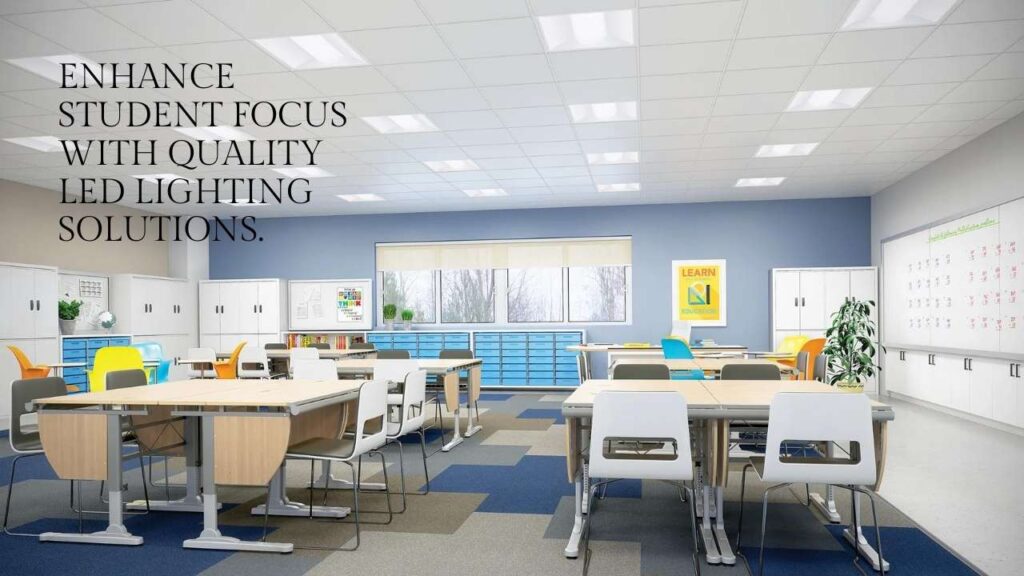In the realm of education, creating conducive learning environments involves meticulous attention to detail, and one critical aspect often overlooked is lighting. The phrase The Best LED Lighting for Schools And Classrooms encapsulates the pursuit of optimal illumination solutions that enhance both educational outcomes and student well-being.
Choosing the right lighting goes beyond mere functionality—it plays a pivotal role in shaping the atmosphere of classrooms, impacting concentration, mood, and overall learning experiences. LED lighting for schools has emerged as a frontrunner in this domain due to its energy efficiency, superior light quality, and ability to create comfortable environments free from flickering and glare.
As educational institutions strive to foster environments that support modern teaching methods and student engagement, understanding the nuances of LED lighting solutions becomes increasingly crucial. From classroom dynamics to hallway visibility, the selection of The Best LED Lighting for Schools And Classrooms not only meets but exceeds the diverse needs of educators and students alike, contributing to a more sustainable and productive learning environment.
Importance of Lighting in Schools and Classrooms
Effective LED classroom lighting solutions play a crucial role in shaping the learning environment within schools and classrooms. The choice of the best LED lighting for educational spaces not only influences visibility but also impacts student performance, concentration levels, and overall well-being. Here’s why investing in quality lighting solutions is essential.
Lighting Effects on Student Performance and Well-being

Research has consistently shown that lighting directly affects students’ ability to concentrate and learn. Properly illuminated classrooms reduce eye strain and fatigue, which can lead to improved academic performance and engagement. LED lighting, in particular, provides consistent, flicker-free illumination that promotes a comfortable learning environment conducive to sustained focus.
Benefits of LED Lighting Over Traditional Options
Compared to traditional lighting sources such as fluorescent bulbs, LEDs offer several advantages:
Energy Efficiency: LED fixtures consume significantly less energy, contributing to cost savings for educational institutions over time.
Longevity: LEDs have a longer lifespan than traditional bulbs, reducing maintenance costs and the frequency of replacements.
Quality of Light: Schools lighting solutions, such as LED lights emit a high-quality, natural light that closely mimics daylight, which has been shown to positively impact mood and productivity among students and teachers alike.
Best LED Lighting Fixtures for Schools and Classrooms
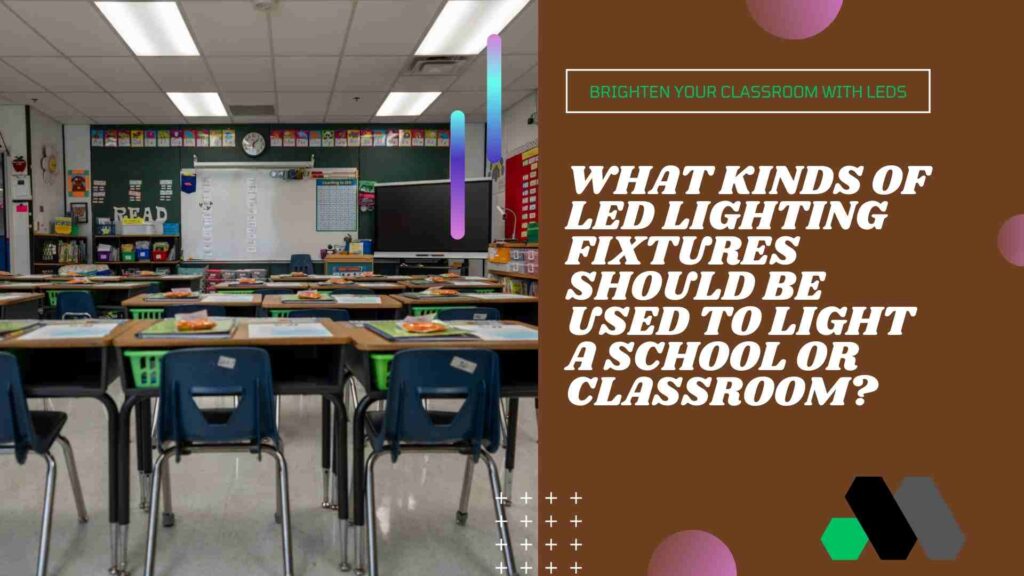
Choosing the right LED lighting fixtures for schools and classrooms depends on several factors:
Types of LED Lighting Fixtures for Educational Settings
Choosing the best LED lighting for schools and classrooms involves selecting fixtures that are not only energy-efficient but also enhance learning environments through optimal illumination. Here are the primary types of LED lighting fixtures suitable for educational settings:
LED Panel Lights
LED panel lights are ideal for classrooms due to their uniform light distribution and low glare. These flat, lightweight panels provide even illumination, minimizing shadows and creating a comfortable learning atmosphere. Available in various sizes and color temperatures, they allow schools to customize lighting solutions. Preferred for their energy efficiency, long lifespan, and flicker-free operation, LED panels reduce eye strain and improve student concentration.
Troffer Lights
Troffer lights are recessed ceiling fixtures ideal for corridors, hallways, and large classrooms. These LED fixtures provide excellent light distribution and brightness control, ensuring visibility in high-traffic school areas. Available in traditional fluorescent tube replacements and modern LED options, they enhance energy savings and maintenance efficiency. Their sleek design and compatibility with smart lighting controls make them popular for modern educational facilities aiming to optimize lighting and reduce costs.
Tube Lights
LED tube lights are an efficient alternative to traditional fluorescent tubes, offering superior light quality and energy savings. Schools can retrofit existing fixtures with LED lighting for classrooms to improve illumination and reduce maintenance costs. Available in various lengths and color temperatures, they provide flexibility to meet specific classroom lighting requirements. Designed for instant-on capability and durability, they are ideal for environments where lighting reliability and performance are critical.
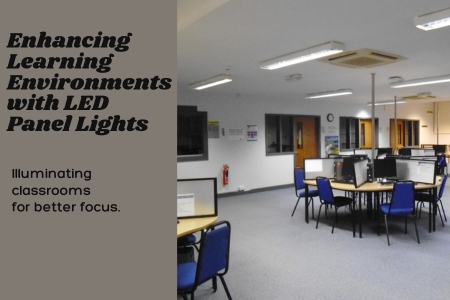
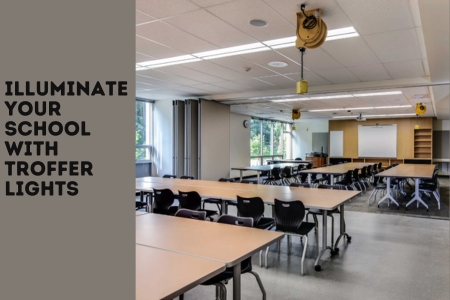
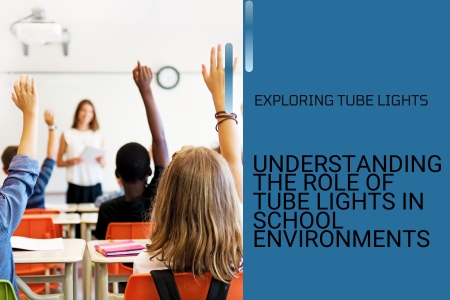
Choosing the Best LED Fixtures for Schools
Selecting the best LED lighting for schools and classrooms involves careful consideration of several key factors to ensure optimal performance and efficiency:
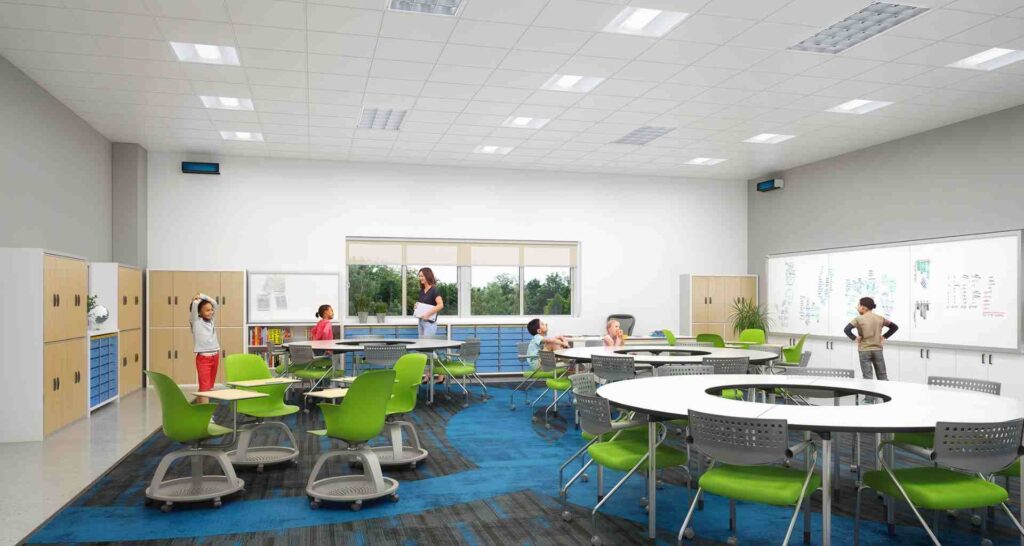
- Brightness and Illumination: LED fixtures should provide sufficient brightness for different classroom activities without causing glare or discomfort. Opt for fixtures with adjustable brightness settings to accommodate varying lighting needs throughout the day.
- Color Temperature: Choose LED lights with appropriate color temperature settings. Cooler temperatures (5000-6500) are suitable for classrooms as they promote alertness and concentration, ideal for morning lessons. Warmer temperatures (2700-3500) create a cozy atmosphere for afternoon activities or calming environments.
- Energy Efficiency: LED lighting is renowned for its energy efficiency compared to traditional fluorescent or incandescent lighting. Look for fixtures with high lumens per watt ratings and ENERGY STAR certifications to maximize energy savings and reduce operational costs for schools.
- Durability and Longevity: LED fixtures have a longer lifespan than conventional lighting options, reducing maintenance and replacement costs over time. Choose fixtures with robust designs and warranties to ensure durability in high-traffic areas such as classrooms and corridors.
- Smart Lighting Controls: Consider LED fixtures with smart lighting capabilities that allow for centralized control and programming. This feature enables schools to adjust lighting schedules, dim lights during non-peak hours, and integrate with daylight harvesting systems for additional energy savings.
Also Read More : BEST LIGHTING FOR YOUR GAME ROOM
Benefits of LED Lighting in Educational Environments
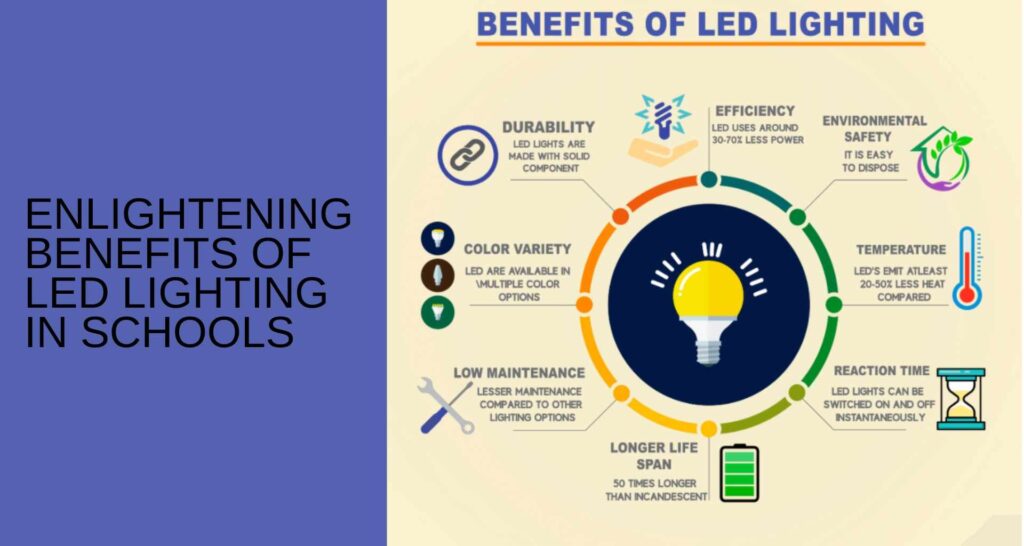
LED lighting offers numerous advantages for schools and classrooms, making it the best LED lighting choice for educational settings:
Energy Efficiency and Cost Savings
LED lights in classrooms are highly energy-efficient, consuming significantly less electricity than traditional lighting options such as fluorescent tubes or incandescent bulbs. This efficiency translates into substantial cost savings for educational institutions over time. Schools can allocate saved funds to other educational resources, enhancing the overall learning environment.
Health Benefits and Reduced Environmental Impact
Unlike fluorescent school lights, LEDs do not flicker, which can cause eye strain and headaches among students and teachers. Educational lighting also emits a more natural light spectrum, enhancing visibility and reducing visual discomfort. Additionally, academic illumination contains no hazardous materials such as mercury, making them environmentally friendly and easier to dispose of responsibly.
Long Lifespan and Low Maintenance
LED fixtures have an exceptionally long lifespan compared to traditional lighting sources. With an average lifespan of up to 50,000 hours or more, LEDs require less frequent replacement, reducing maintenance costs and downtime in classrooms. This longevity contributes to a more sustainable and efficient lighting solution for schools.
Best Practices for Implementing LED Lighting in Schools
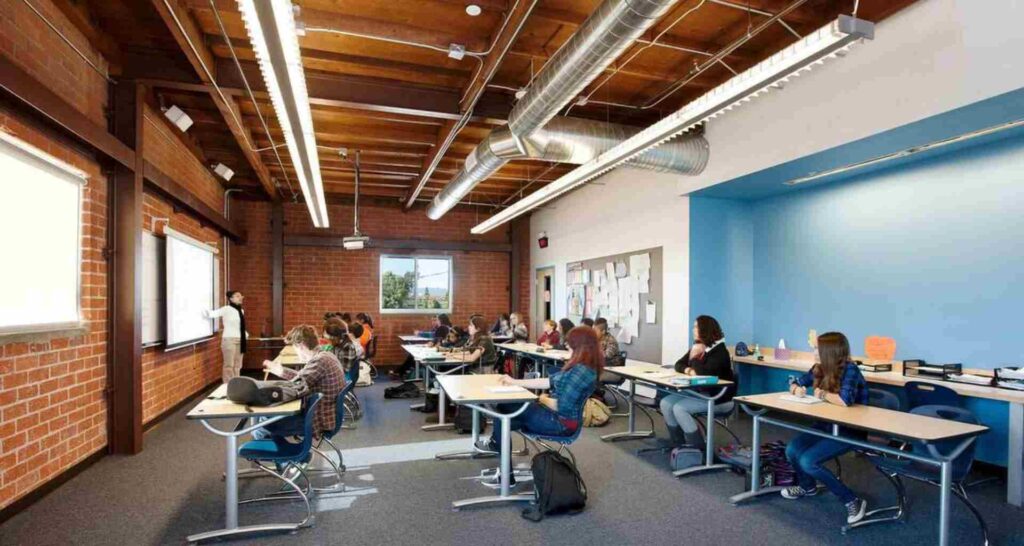
Implementing the best LED lighting for schools and classrooms involves strategic planning and considerations to maximize efficiency and effectiveness:
Design Considerations: Optimize lighting design to ensure uniform illumination across classrooms and common areas. Use LED panel lights for classrooms to provide even distribution without glare, enhancing visibility and reducing eye strain for students and teachers alike.
Energy Efficiency: Select LED fixtures for schools with high energy efficiency ratings to reduce operational costs. LEDs consume significantly less energy than traditional lighting sources, resulting in long-term savings for educational institutions.
Color Temperature and Brightness: Choose fixtures with adjustable color temperatures to create environments conducive to different learning activities in schools. Cooler temperatures (5000K-6500K) are suitable for focused tasks, making LED lights for schools ideal for areas where concentration is essential. Meanwhile, warmer temperatures (2700K-3500K) promote a relaxed atmosphere during collaborative sessions, ensuring that the lighting can adapt to the dynamic educational needs.
Maintenance and Sustainability: Incorporate LED classroom lighting fixtures with long lifespans and minimal maintenance requirements. LEDs have longer operational lifetimes and require fewer replacements compared to fluorescent or incandescent bulbs, reducing maintenance disruptions and associated costs in educational environments. This makes LED classroom lighting not only a cost-effective choice but also enhances the learning atmosphere through better illumination quality.
Conclusion
In conclusion, the choice of the best LED lighting for schools and classrooms is pivotal in shaping modern educational environments that prioritize both learning outcomes and student well-being. LED technology offers significant advantages over traditional lighting solutions, including enhanced energy efficiency, superior light quality, and reduced maintenance costs. These benefits make LED lights in classrooms a fundamental component of contemporary educational strategies, optimizing both the illumination and the atmosphere conducive to effective learning.
By embracing LED lighting solutions tailored to educational settings, schools can create optimal learning environments that support student concentration, engagement, and overall academic performance. From classrooms to corridors, the implementation of strategic lighting designs not only improves visibility but also contributes to a sustainable and cost-effective operational model for educational institutions.
Moreover, the benefits of LED lighting for schools extend beyond immediate savings and efficiency gains.. LED lighting for schools promotes a healthier and more comfortable learning environment by minimizing glare and providing customizable lighting options to suit diverse teaching methodologies.

